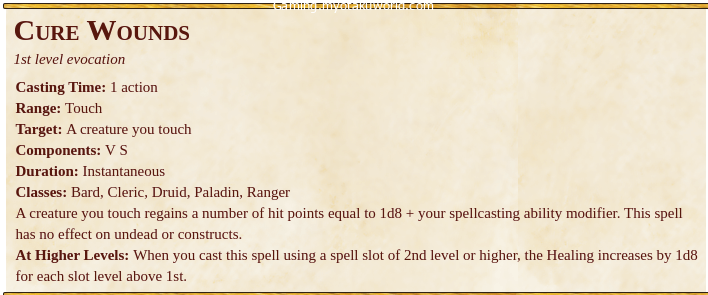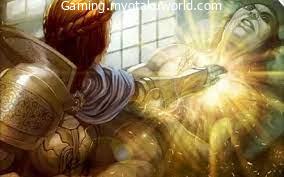The ultimate heal spell- ‘Cure Wounds’- provides old-fashioned comfort in the updated edition.
The spell is available to more classes than in previous editions, making it accessible via a variety of sources. It is a must for any group that is out and about.
The regulations for curing Wounds are inside the Players Handbook on page 230.
Cure Wounds 5e

- Evocation: 1st Level
- Casting Time: 1 Action
- Range: Touch
- Components: V, S
- Duration: Instantaneous
The creature you touch will gain the number of damage points equivalent to 1d8 plus the spellcasting ability modifier. This spell does not have any effect on undead creatures.
At higher levels, casting this spell using a slot with a 2nd or higher level the healing increases by 1d8 for each that is higher than the 1st.
These rules of ‘Cure Wounds’ describe this spell to be a touch-based healing power. It provides a tiny 1d8 base, plus a spell casting modifier healing to all creatures.
It also explains that it can’t be used to heal or harm undead or constructs.
Do I need to cast a cure for wounds?
‘Cure Wounds’ is an old healing spell. This spell is available in almost every RPG across the globe. The effect of the spell increases the health of an ally and enables them to continue fighting.
However, the most important question is whether the risk of losing an attack or moving to assist an ally is worth it. Most of the time the answer shockingly is yes.
The advantages of curing wounds are often masked by nostalgia and are not capable of being truly effective.
At first, when ‘Cure Wounds’ is used, it can return an ally’s health to its fullest and could be an important difference in the battle between life or death.
The character has more specific casting slots for spells that are extremely limited, and so the use of healing spells dramatically decreases the impact of the caster during battle.
This can make the character feel unimportant when an opponent cancels out the advantages of the spell within a single turn.
For example, the combatant is toe-to-toe in a fight with goblins. The combatant begins the battle having 12 points of a hit. Goblins wield a small sword that deals 1d6+ damage.
If a few rolls go wrong in the fight and the character is reduced to two hit points, the group turns to the cleric to get an ointment to Cure Wounds on the fighter.
‘Cure Wounds’ Level 1 heals 1d8 plus modifier (+3 on this instance). If the Clergy applies the magic spell and rolls an average (4) for the spell, the player will be healed of 7 (roll 4plus modifier 3,) hits.
The cleric’s turn ends. On the following turn, the goblin strikes again. It is possible for the goblin to inflict 7 damage in a straight roll. This gives the spell casting the appearance of wash.
It is possible to argue that the cleric must attack the goblin. The character will then have the power to defeat the goblin and help keep the fighter alive.
Because Cure Wounds can be a touch-based spell, the cleric needs to be close. The removal of the threat, followed by recovering hit points using an ointment or shorter rest may be the best option.
Hot Tip: The significance of healing spells is dependent on the potency of the potion. If the party is equipped with multiple potions for healing, then the spells will be less crucial since the potions are identical but don’t use the caster’s actions. If the potions are infrequent and scattered, they place more emphasis on healing spells, and what ones are the best.
Who gets Cure Wounds?
In 5e, a variety of classes can make use of ‘Cure Wounds’. This is a significant change compared to the other generations.
In the past, the role of the party healer was assigned to the class of clerics. The role of party healer is now able to be filled by other classes. into the role to keep the party members healthy.
The classes with the most basic ability to heal injuries are the Artificer Bard Cleric, Druid Paladin, and the Ranger.
The requirement for a cleric to be part of an alliance to maintain balance is drastically reduced. However, it lets the cleric play with other spells more often.
Apart from the standard classes, several subclasses gain access to the ability to heal Wounds.
For instance, the Divine Soul Sorcerer Celestial Warlock and Mark of Healing Dragonmark can take and cast the spell.
Bottom Line: The cleric class shouldn’t necessarily be viewed as the healer of the whole group. It was a common impression in the class in earlier versions. There is a good chance that there’ll be some sort of healer within every group, even if it is just in the nick of time. The cleric can use powerful spells without worrying about reserving slots to heal your teammates during every fight.
Cure Wounds in contrast to Healing Word
The introduction of spells such as Healing Word has drastically reduced the effectiveness of Cure Wounds.
The most effective use for Cure Wounds, or any other healing spell that has a roll, is to help keep allies alive even when they are weakened.
In this instance, it takes only one point of healing to get someone to their feet.
Comparing Cure Wounds with Healing Word in a side-by-side comparison is the most effective method to determine which one is superior;
Treat Wounds
- Heal 1d8+Mod (+1d8 per level above 1)
- Touch-based
- Makes a move
- Somatic and Verbal Components
Healing Word
- Heal 1d4+Mod (+1d4 per level above 1)
- 30-foot range
- Does an Extra Action
- Verbal Components
Comparing these two spells in this way allows you to determine which one is a more effective option if the objective is to ensure that allies are alive.
Remember that it only takes one point of healing magic to keep someone from being in the fight or acting normal according to the rules of the game.
That means that healers can use the Healing Word and take action but remain safe if the need arises. This is not feasible using Cure Wounds.
Hot Tip: Comparison of Cure Wounds to Healing Word is intended for classes that have this option. The list of spellcasters who have accessibility to Healing Word is significantly smaller than the list of casters who can benefit from Cure Wounds. The comparison assumes that the person who benefits from the spell is able to take care of themselves during their turn or be protected from damage until the end of the battle.
Final Words
Cure Wounds is an old spell but the modifications introduced in 5e have made it appear to be a little nebulous at times. It’s probably best used to heal yourself in emergencies.
The addition of healing capabilities to a variety of classes has indeed reduced the need for the cleric to serve as the team’s “healer”, but it has also provided the chance for the cleric’s growth into one of the most effective classes in the game.
They can access an extensive list of spells that are packed with powerful spells. You can be a cleric and not feel pressured to be “just healer”.
FAQs
Is Cure Wounds a Good Spell?
Cure Wounds isn’t a bad spell, but you should take Healing Word instead if your character can. Healing Word is a free action, but Cure Wounds uses your whole action. But if Cure Wounds is the only 1st-level healing spell you have, it’s always better to have something than nothing.
Which Classes Can Use Cure Wounds?
Bards, Clerics, Druids, Paladins, Rangers, Celestial Warlocks, and Artificers can all use the Cure Wounds skill. It is always ready for Druids of the Circle of Wildfire and Clerics of the Life Domain.









